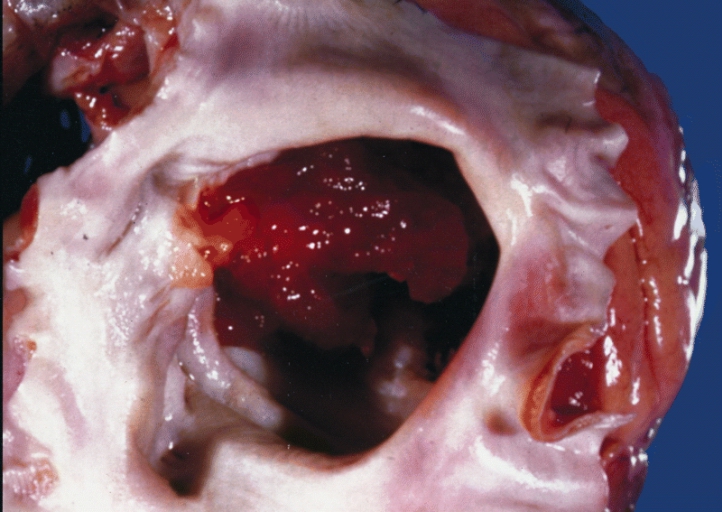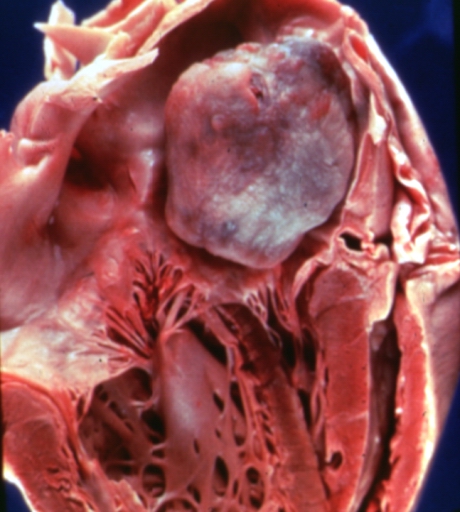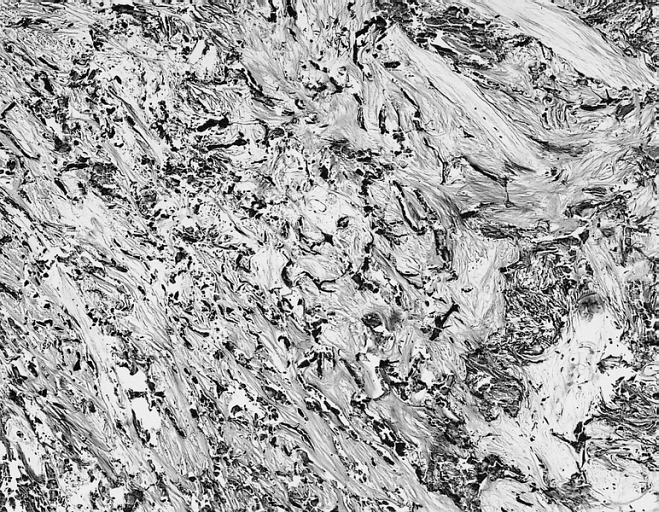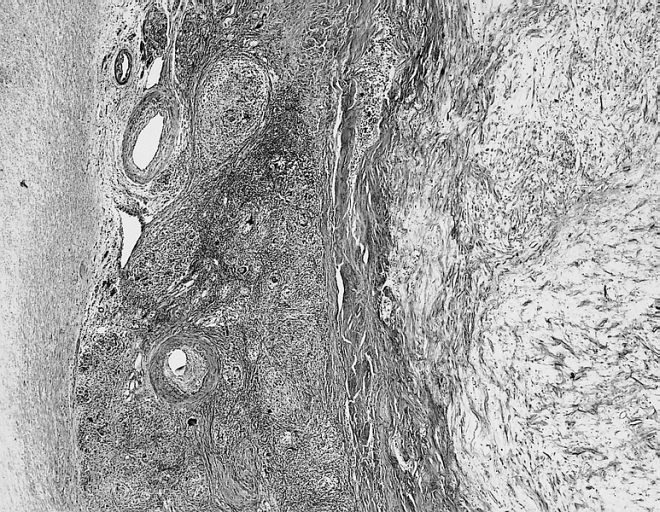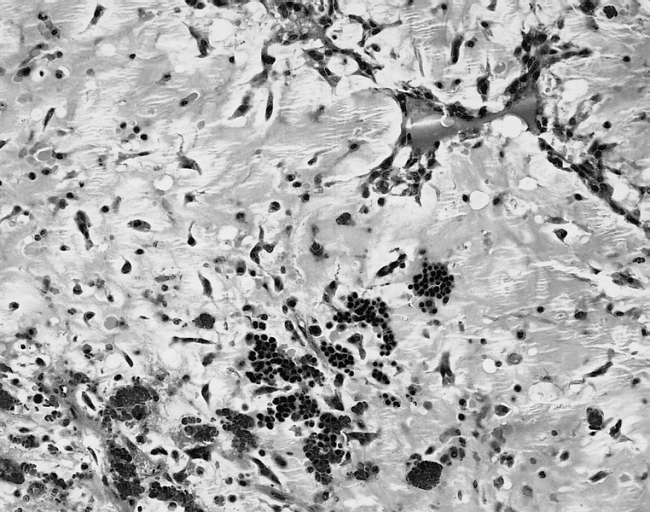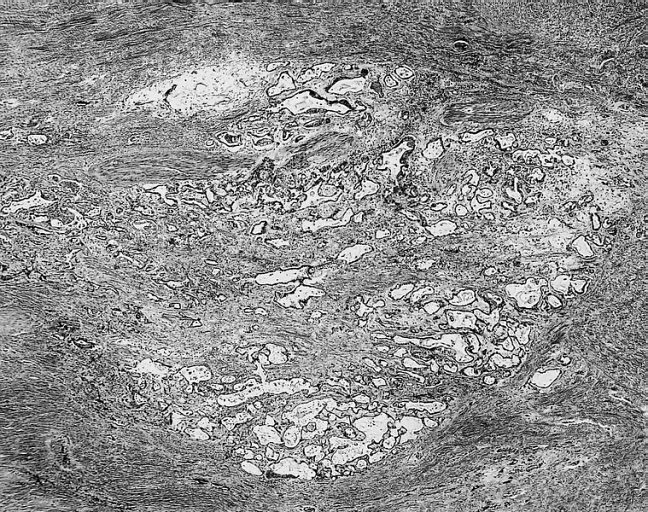Myxoma pathophysiology: Difference between revisions
No edit summary |
No edit summary |
||
| Line 3: | Line 3: | ||
{{CMG}} {{AE}} {{CZ}}{{AAM}}{{MV}} | {{CMG}} {{AE}} {{CZ}}{{AAM}}{{MV}} | ||
==Overview== | ==Overview== | ||
Cardiac myxoma contains undifferentiated mesenchymal cells, which potentially differentiate into many tissues such as blood vessels, glandular structures, bones, and source of extramedullary hematopoiesis. | |||
==Pathophysiology== | ==Pathophysiology== | ||
Cardiac myxoma arises from myxoid collagenous [[stroma]], which is composed of mesenchymal cells that are normally involved in the supportive structure of the tissue. Myxomas are usually located in the [[endocardium]] of the [[atrial septum]]. Some symptoms of myxoma may be associated with the release of [[interleukin 6]] (IL-6) by the myxoma.<ref name="Seino-IL6">{{cite journal | author=Seino Y, Ikeda U, Shimada K. | title=Increased expression of interleukin 6 mRNA in cardiac myxomas. | journal=Br Heart J | year=1993 | volume=69 | issue=6 | pages=565-7 | id=PMID 8343326}}</ref><ref name="Jourdan-IL6">{{cite journal | author=Jourdan M, Bataille R, Seguin J, Zhang XG, Chaptal PA, Klein B | title=Constitutive production of interleukin-6 and immunologic features in cardiac myxomas.| journal=Arthritis Rheum | year=1990 | volume=33 | issue=3 | pages=398-402 | id=PMID 1690543}}</ref> | Cardiac myxoma arises from myxoid collagenous [[stroma]], which is composed of mesenchymal cells that are normally involved in the supportive structure of the tissue. Myxomas are usually located in the [[endocardium]] of the [[atrial septum]]. Some symptoms of myxoma may be associated with the release of [[interleukin 6]] (IL-6) by the myxoma.<ref name="Seino-IL6">{{cite journal | author=Seino Y, Ikeda U, Shimada K. | title=Increased expression of interleukin 6 mRNA in cardiac myxomas. | journal=Br Heart J | year=1993 | volume=69 | issue=6 | pages=565-7 | id=PMID 8343326}}</ref><ref name="Jourdan-IL6">{{cite journal | author=Jourdan M, Bataille R, Seguin J, Zhang XG, Chaptal PA, Klein B | title=Constitutive production of interleukin-6 and immunologic features in cardiac myxomas.| journal=Arthritis Rheum | year=1990 | volume=33 | issue=3 | pages=398-402 | id=PMID 1690543}}</ref> | ||
===Gross Pathology=== | ===Gross Pathology=== | ||
On gross pathology, external appearance, consistency size and weight are extremely variable findings of cardiac myxoma. Large cardiac myxomas are usually located in [[fossa ovalis]] and tend to be sessile or pedunculated. Tumor consistency depends on the quantity and distribution of fibrous tissue and calcification. | On gross pathology, external appearance, consistency size and weight are extremely variable findings of cardiac myxoma. Large cardiac myxomas are usually located in [[fossa ovalis]] and tend to be sessile or pedunculated. Tumor consistency depends on the quantity and distribution of fibrous tissue and calcification. A macroscopic gelatinous, irregular surface that fills the [[left atrium]] is a characteristic finding of myxoma. | ||
[http://www.peir.net Images shown below are courtesy of Professor Peter Anderson DVM PhD and published with permission © PEIR, University of Alabama at Birmingham, Department of Pathology] | [http://www.peir.net Images shown below are courtesy of Professor Peter Anderson DVM PhD and published with permission © PEIR, University of Alabama at Birmingham, Department of Pathology] | ||
Revision as of 20:22, 13 November 2015
|
Myxoma Microchapters |
|
Diagnosis |
|---|
|
Treatment |
|
Case Studies |
|
Myxoma pathophysiology On the Web |
|
American Roentgen Ray Society Images of Myxoma pathophysiology |
|
Risk calculators and risk factors for Myxoma pathophysiology |
Editor-In-Chief: C. Michael Gibson, M.S., M.D. [1] Associate Editor(s)-in-Chief: Cafer Zorkun, M.D., Ph.D. [2]Ahmad Al Maradni, M.D. [3]Maria Fernanda Villarreal, M.D. [4]
Overview
Cardiac myxoma contains undifferentiated mesenchymal cells, which potentially differentiate into many tissues such as blood vessels, glandular structures, bones, and source of extramedullary hematopoiesis.
Pathophysiology
Cardiac myxoma arises from myxoid collagenous stroma, which is composed of mesenchymal cells that are normally involved in the supportive structure of the tissue. Myxomas are usually located in the endocardium of the atrial septum. Some symptoms of myxoma may be associated with the release of interleukin 6 (IL-6) by the myxoma.[1][2]
Gross Pathology
On gross pathology, external appearance, consistency size and weight are extremely variable findings of cardiac myxoma. Large cardiac myxomas are usually located in fossa ovalis and tend to be sessile or pedunculated. Tumor consistency depends on the quantity and distribution of fibrous tissue and calcification. A macroscopic gelatinous, irregular surface that fills the left atrium is a characteristic finding of myxoma.
-
A gelatinous tumor is attached by a narrow pedicle to the atrial septum. The myxoma has an irregular surface and nearly fills the left atrium.
-
Left Atrial Myxoma
Microscopic Pathology
On microscopic histopathological analysis, Gamna-Bodies consist of fibrosis and deposition of iron pigments are characteristic findings of myxoma. Myxoma cells can be elongated, fusiform or stellate. They contain modest amounts of eosinophilic cytoplasm and have oval nuclei.
-
Cardiac Myxoma: Gamna Bodies: A peculiar form of fibrosis with deposition of iron pigment, identical to that seen in the spleens of patients with sickle cell anemia, is not uncommon in myxoma.
-
Cardiac Myxoma Common features at the interface with the atrial septum include lymphoid aggregates, smooth muscle bundles, and thick walled vessels which angiographically may look like neovascularization.
-
Cardiac Myxoma The extramedullary hematopoiesis seen here is present in about 7 percent of cardiac myxomas.
-
Cardiac Myxoma Glandular structures are seen in less than 5 percent of cases. In this example, they were limited to the base of the myxoma
References
- ↑ Seino Y, Ikeda U, Shimada K. (1993). "Increased expression of interleukin 6 mRNA in cardiac myxomas". Br Heart J. 69 (6): 565–7. PMID 8343326.
- ↑ Jourdan M, Bataille R, Seguin J, Zhang XG, Chaptal PA, Klein B (1990). "Constitutive production of interleukin-6 and immunologic features in cardiac myxomas". Arthritis Rheum. 33 (3): 398–402. PMID 1690543.
